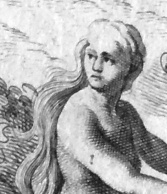The ‘Women in the special collections of Trinity Hall’ is an occasional series to celebrate the ‘TH Women 40’ anniversary. In this first post of the series we look at two very different depictions of Eve, the first woman, published two hundred years apart.
Nuremberg Chronicle
The Nuremberg Chronicle, or ‘Chronica Mundi’, is a history of the world. Written by Hartman Schedel and printed by Anton Koberger in 1493 (a year after Christopher Columbus sailed to the ‘new world’) the Nuremberg Chronicle reflects the medieval world view.

Creation of Eve. Nuremberg Chronicle (detail).
It includes a large number of woodcuts by Michel Wolgemnut and Wilhelm Pleydenwurff of city scenes, historical figures and events. At this time, sources for European history were the Bible and the Classics which is why figures from the Old Testament mingle with those from Greek and Roman history. Some of the illustrations include women and give a fascinating insight into the medieval view of women – including Eve. An opening near the start of the book shows God creating Eve out of Adam’s rib. Eve is born, fully-formed, as a comely young woman who gazes directly at her Creator.

Temptation of Adam and Eve in Paradise. Nuremberg Chronicle (detail)
On the facing page we see the temptation of Eve and the expulsion from Paradise. Adam and Eve are of an equal height standing either side of the tree of knowledge. Each holds a red apple in their hands, while the serpent has another apple in its mouth. The couple cover their bodies in shame, although only Eve casts down her eyes. She is shown as curvaceous, vigorous and grounded. Moreover, in our hand-coloured copy she is alluring, with long blonde hair, red lips and pink flesh tones.

Medieval face of Eve. Nuremberg Chronicle (detail)
The Nuremberg Chronicle abounds with other arresting images of women, who are often portrayed as lively and confident: from women of Roman antiquity to the women of the Old and New Testaments.
Paradise Lost
‘The poetical works of Mr. John Milton’, published in 1695, was the first collected edition of Milton’s poems. It includes the epic poem ‘Paradise lost’ which tells the tale of the Fall and the expulsion of Adam and Eve from the Garden of Eden.
Milton was a republican and a civil servant during the Oliver Cromwell’s Commonwealth. He composed his epic poem ‘Paradise Lost’ in 1667, after the Restoration of the monarchy in 1660. England had endured a period of religious and political upheaval. The trauma of the Civil War and the collapse of the Commonwealth brought tremendous soul searching: families had been torn apart and individuals were buffeted by changing fortunes. Gone were the medieval certainties.

Frontispiece to Book 9 of Paradise Lost (1695)
A new insecurity is revealed in these illustrations to ‘Paradise Lost’. In the frontispiece to Book IX we see Adam and Eve in a sunny paradise but surrounded by dark forces. Their small figures are dwarfed by the coiled serpent and a prancing Satan in the gloomy foreground. Eve’s face is blank in her innocence and, as if in a dream, she seems powerless to withstand the inexorable sequence of events. Both the engraving and Milton’s introduction leave us in no doubt about the prime mover: ‘Satan having compast the Earth, with meditated guile returns as a mist by night into Paradise, enters into the Serpent sleeping’.

Milton’s Eve in Paradise
The engraving captures the moment when Satan wakes the serpent from his sleep. We see the serpent spiralling up above Satan’s head (almost like a thought bubble) and mesmerising Eve, who takes a bite of the apple. She then hands an apple to Adam, who takes it and bites into it. The fatal deed is done! Thunder clouds mass overhead and lightning strikes, symbolising the voice and wrath of God at their disobedience. The final vignette depicts their misery at having disobeyed God by tasting the forbidden fruit. They realise that they are naked and cover themselves with leaves. Here Eve, Adam and even the serpent are all depicted as pawns in Satan’s titanic battle with God.

Detail of frontispiece to Book 12 of Paradise Lost (1695)
The frontispiece to Book XII reinforces this feeling of powerlessness. Adam and Eve are driven from the Garden of Eden by the Archangel Michael, who holds a flaming sword. The couple seems traumatised and full of guilt. Adam hides his face but we see the doleful face of Eve, with huge saucer eyes looking up towards heaven, or perhaps towards an uncertain future outside paradise.

Milton’s Eve on her expulsion from Paradise
Milton tells us that she is ‘compos’d to quietness of mind and submission’. This is a very different Eve from the medieval Eve of the Nuremberg Chronicle, who looked confident and knew her place in the world. The seventeenth-century Eve is conflicted, haunted and worried about the future – a modern Eve for troubled times.








